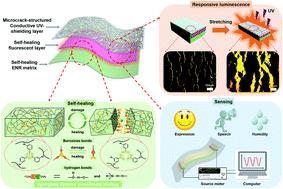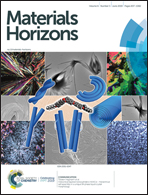A cephalopod-inspired mechanoluminescence material with skin-like self-healing and sensing properties†
Abstract
Animal skins possess multiple fascinating functions for acclimatization and survival, including displaying colorful patterns, wound healing and detecting various stimuli. Although tremendous progress in skin-mimicking materials has been achieved, it remains a great challenge for them to integrate these attractive properties into one single material system. Here, inspired by the cephalopod skin, we describe a mechanoluminescence material with skin-like self-healing and sensing properties based on nanostructured self-healable supramolecular elastomer composites. The resulting multifunctional material exhibits polychrome fluorescence and dazzling patterns under stretching, and is capable of sensing environmental variations including stress and humidity. Besides, benefiting from the excellent self-healing properties of the supramolecular elastomer matrix with synergistic interactions of dynamic-covalent and hydrogen bonds, this material can self-recover both strain-responsive fluorescence and sensing ability at ambient temperature after break. This bio-inspired multifunctional material demonstrates great potential for applications in future optoelectronics, encryption devices, electronic skins and intelligent robot fields.

- This article is part of the themed collections: 2019 Materials Horizons Most Popular Articles and A selection of 2019 articles


 Please wait while we load your content...
Please wait while we load your content...